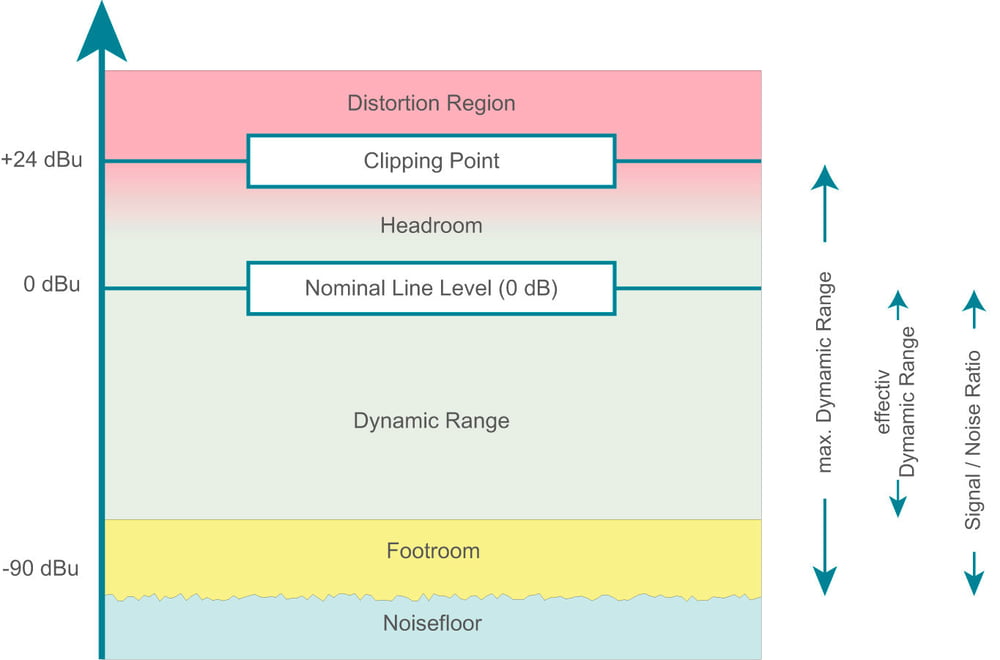3. Dynamic range
As members of the family of dynamic processors, compressors are used to process the dynamic range of an audio signal. But what does this mean exactly? Generally speaking, the dynamic range describes the difference between the maximum and minimum levels. Depending on the context, this general definition can have a variety of meanings.
Original dynamic range
The original dynamic range (musical dynamics) is the unaltered range of levels from the sound source(s), e.g. the dynamics of an orchestra from piano pianissimo (ppp) to forte fortissimo (fff).
System dynamic range (technical dynamic range)
This describes the dynamic range of your equipment. The maximum system dynamic range (as defined by the noise floor and the maximum undistorted level), must be distinguished from the effective system dynamic range, which is the usable range between the so-called headroom and footroom. These are implemented as safety margins to ensure good quality recordings.
How effectively the system dynamic range is utilized depends on the recording level, which should neither be set too high nor too low. If the signal is too quiet and falls below the footroom, it dissipates in noise. All electronic systems have an inherent basic noise floor which stems from the unavoidable thermal noise of the components. At the other end, above the headroom, the signal is audibly distorted. In analog systems, the distortion increases progressively as the level rises, while digital systems will distort the signal abruptly and violently.
On analog equipment such as mixing consoles, the maximum level is marked as the operating level or 0 dB. In digital systems, the maximum level is theoretically identical to the distortion limit (0 dBFS). Due to the sudden onset of distortion, this isn't practical, which is why digital audio systems are designed with additional "virtual headroom".
Playback dynamic range
This describes the useful dynamic range at the listening end. Its lower boundary is determined by the volume of the ambient noise, while its upper limit is the pain threshold, or the noise tolerance of others in the area, whatever is lower. See an example below.
Program dynamic range
The program dynamic range (target dynamic range) is the dynamic range of an audio signal which has been processed to meet the criteria of the expected playback dynamic range. This is the dynamic range of the finished audio signal on the record.
In practice, the original dynamic range is usually greater than both the system and playback dynamic ranges. Therefore, it must be limited so that the audio signal fits into the effective system dynamic range and can be played back at a normal playback dynamic range.
Here's an example. In residential buildings, an ambient noise floor of about 35-40 dBSPL can be considered normal. In multi-family dwellings, it must be taken into consideration that the neighbors might perceive the audio signal as a disturbance. Consequently, the noise level must not exceed 35-40 dBSPL in the neighbors' flat, after it has passed through the wall. Assuming an average wall absorption rate of about 40-50 dBSPL, the listening level should not exceed 90 dBSPL. Therefore, the maximum playback dynamic range cannot be greater than about 40-50 dB. The usable range is even smaller, because the quietest signal level should not fall below about 20 dB above the ambient noise floor, to ensure undisturbed listening pleasure. As a result, the program dynamic range must be limited to approximately 20-30 dB. While dynamic ranges of up to 30 dB are common in classical music and jazz, the dynamic range of most rock and pop music does not exceed 10 dB. In extreme cases, modern productions can be heavily compressed to a dynamic range of 3 dB. In this case, the music is perceived as „loud“, but at the same time it tends to sound dull and lifeless. In recent years, some professional mixing and mastering engineers have renounced this trend and increased the dynamic ranges of their productions.
As another example, imagine a large symphony orchestra in a quiet concert venue with an ambient noise level of about 20 dBSPL. The quietest sections are at about 20 dB above the ambient noise and are clearly audible. A large orchestra can reach a dynamic range of 60 dB. This means that the maximum level is around 100 dBSPL, which is similar to a disco. If this dynamic range were to be played back without compression in the flat from the previous example, one would have to expect a maximum level of 120 dBSPL! This is near the pain threshold and can lead to severe hearing damage.
As a result, limiting the dynamic range of your recordings makes perfect sense and is one of the essential processes during production. The most basic way of doing this is by supervising the levels and adjusting them manually as needed, using the faders of the mixing console („gain riding“). This practice can be used effectively in classical music, provided that the mixing engineer knows the score. In rock and pop productions, however, it is only useful to a certain extent. While fundamental level adjustments can be made in this manner (macro dynamics), it is impossible to react to sudden level changes, especially with percussive instruments like drums (micro dynamics). This is where the compressor comes in.


